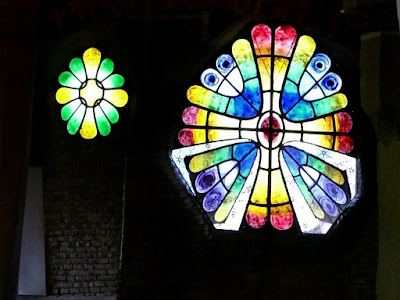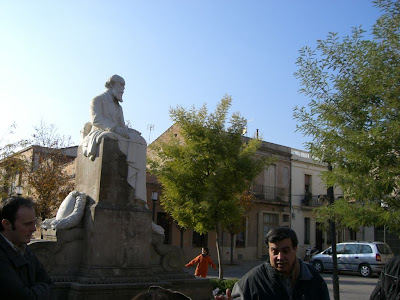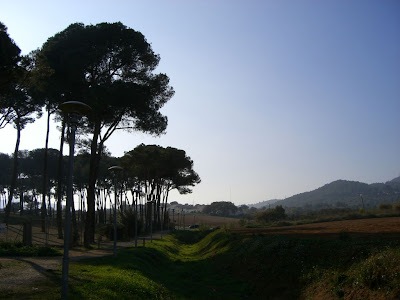After the two previous posts about La Casa Milà (or La Pedrera), I think that it could be interesting to speak about La Colònia Güell, which I visited some time ago.
La Colònia Güell is one of the greatest legacies in modernist architecture and urban design in Spain today. Built at the end of the 19th century, it comprises a factory area, a residential area and the Gaudí Church Crypt, one of the most representative works of Antoni Gaudí. Its buildings are outstanding for their spaciousness, formal beauty and simple shapes and volumes.
The Colònia Güell was founded in 1890 by Eusebi Güell, following the model of the industrial estates common of that time and was one of the largest industrial complexes in Catalonia, where the people worked, lived and learned.
Industrial estates were organized as social centres where the workers and their families lived around the factory. At the factory raw cotton was processed into high quality corduroy and velvet.
The crypt of the church of this industrial estate was a "lab" for Gaudí, as many of the complex architectural solutions the brilliant architect would latter apply in the Sagrada Familia were tested here, in this textile neighborhood.
La Colònia Güell is one of the greatest legacies in modernist architecture and urban design in Spain today. Built at the end of the 19th century, it comprises a factory area, a residential area and the Gaudí Church Crypt, one of the most representative works of Antoni Gaudí. Its buildings are outstanding for their spaciousness, formal beauty and simple shapes and volumes.
The Colònia Güell was founded in 1890 by Eusebi Güell, following the model of the industrial estates common of that time and was one of the largest industrial complexes in Catalonia, where the people worked, lived and learned.
Industrial estates were organized as social centres where the workers and their families lived around the factory. At the factory raw cotton was processed into high quality corduroy and velvet.
Church's Crypt
The crypt of the church of this industrial estate was a "lab" for Gaudí, as many of the complex architectural solutions the brilliant architect would latter apply in the Sagrada Familia were tested here, in this textile neighborhood.
 The current church of La Colònia Güell is actually the crypt of the modernist original design, but the lack of funds stopped its construction. Even though it was never finished, the Crypt, conceived by Gaudí, is considered one of the most important and surprising works in modern architecture
The current church of La Colònia Güell is actually the crypt of the modernist original design, but the lack of funds stopped its construction. Even though it was never finished, the Crypt, conceived by Gaudí, is considered one of the most important and surprising works in modern architecture One of the stained glass window, designed by Gaudí, of the modernist church of La Colònia Güell seen from within
One of the stained glass window, designed by Gaudí, of the modernist church of La Colònia Güell seen from withinColònia Güell
 Ca l'Ordal is a set of three apartments which evokes a traditional Catalan Masia but built in modernist style, like the other buildings of La Colònia Güell
Ca l'Ordal is a set of three apartments which evokes a traditional Catalan Masia but built in modernist style, like the other buildings of La Colònia Güell  The building of Joaquim Folguera library was built between 1915-1917. At first it was a girls school, then a parochial center and, currently is a library
The building of Joaquim Folguera library was built between 1915-1917. At first it was a girls school, then a parochial center and, currently is a library In the middle of Joan Güell Square there is a sculpture of Antoni Gaudí, the brilliant modernist architect
In the middle of Joan Güell Square there is a sculpture of Antoni Gaudí, the brilliant modernist architect The Colònia Güell is surrounded by wheat-fields and pine-trees. The estate is integrated with the rural environment that gives character to the village
The Colònia Güell is surrounded by wheat-fields and pine-trees. The estate is integrated with the rural environment that gives character to the village
As I tried to explain in this post, the Colonia Güell is set in a prime industrial location close to Barcelona, estructured round and enclosing a superb environment with easy acces from the city center, airport and city public transport.
Clicking on the next links you will find more pictures of the most important buildings designed by Antoni Gaudí:
Clicking on the next links you will find more pictures of the most important buildings designed by Antoni Gaudí:
- Sagrada Familia
- Park Güell
- Casa Vicens
- Casa Milà (also known as La Pedrera)
- Casa Batlló
- Palau Güell
- Casa Calvet
- Torre Bellesguard
- Pabellons Güell
- Col·legi de les Teresianes
- El Capricho (built in Comillas, a lovely village in Cantabria)
Besides, other modernist buildings you can visit in Barcelona are:
- Hospital de Sant Pau
- Palau de la Música Catalana
- La Boqueria
- Casa Fuster
- Casa Terrades or "Casa de les Punxes"
- Casa Thomas
- Casa Amatller
- Casa Lleó i Morera
- Casa Martí (Restaurant els Quatre Gats)
Other interesting one day visits you can enjoy near Barcelona are:
- Castelldefels
- Sitges
- Montserrat Monastery
- Sant Miquel del Fai
- Circuit de Catalunya in Montmeló
- Girona
- Teatre-Museu Dalí
Besides I would like to give you some useful information in case you want to visit La Colònia Güell:
- Address: Claudi Güell, 6 (08690 Santa Coloma de Cervelló)
- How to get there:
- By car: By road B-2002 between Sant Boi de Llobregat and Santa Coloma de Cervelló. for detailed indication consult the following location map of La Colonia Güell.
- By train: Ferrocarrils de la Generalitat de Catalunya (FGC) from Plaza España (Barcelona). Lines S33, S8 y S4. Station: Colònia Güell.
- Opening times
- Winter season: 1st of November until the 1st of June from 10.00 - 15.00h
- Summer season: 1st of June until the 31st of October from 10.00h - 14.00h and from 15.00h - 19.00h.
- Weekends and holiday all the year from 10.00 - 15.00h.
- Telephone: 93 630 58 07
- Email: info@coloniaguell.net
- Website: www.coloniaguell.net
- Barcelona Guide Bureau (http://bgb.es) offers guided tours with transfer from Barcelona.
Finally, clicking on the next link you will find links to other beautiful places in Barcelona and Catalonia, among them, more nice modernist buildings in Barcelona.
- Email: info@coloniaguell.net
- Website: www.coloniaguell.net
- Barcelona Guide Bureau (http://bgb.es) offers guided tours with transfer from Barcelona.
Finally, clicking on the next link you will find links to other beautiful places in Barcelona and Catalonia, among them, more nice modernist buildings in Barcelona.




No hay comentarios:
Publicar un comentario